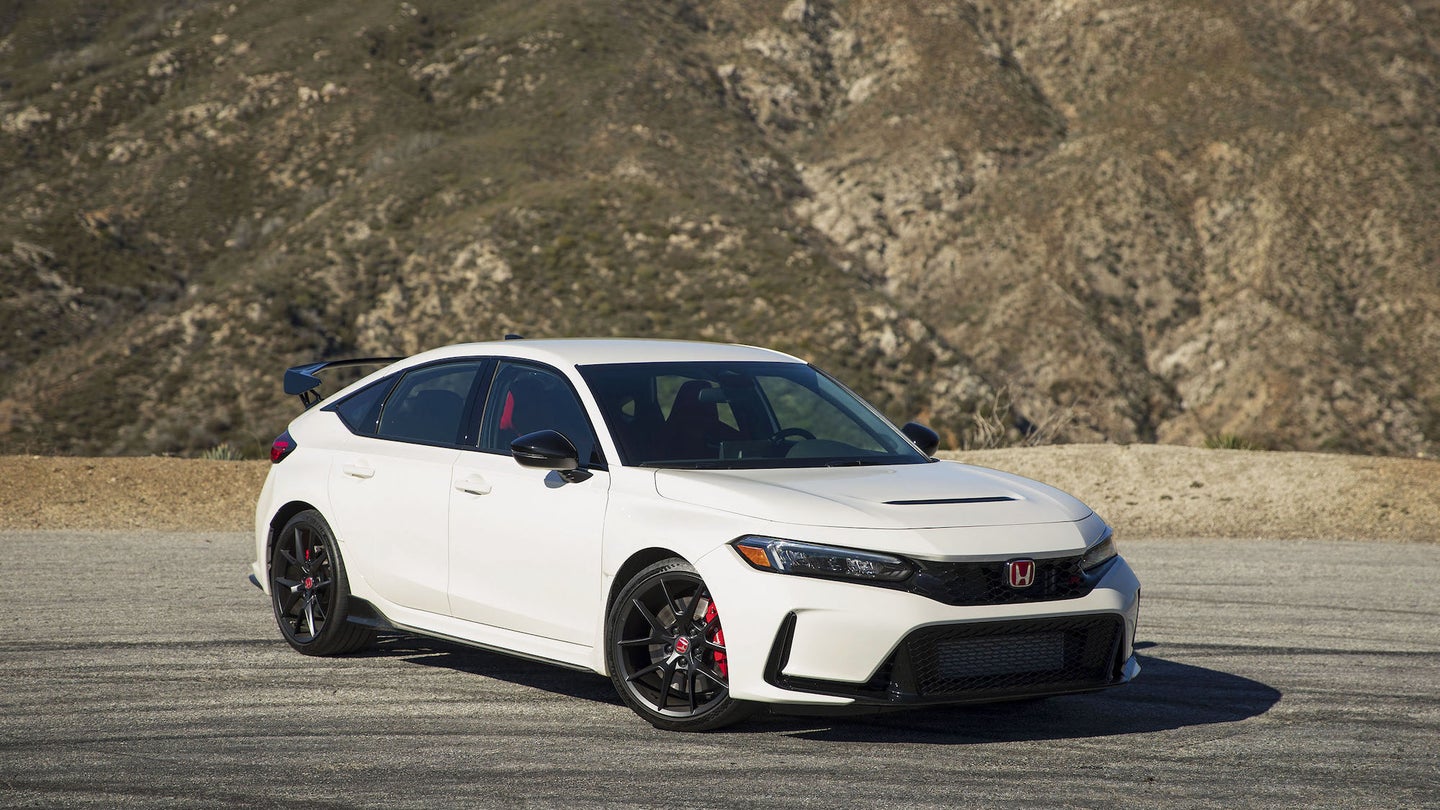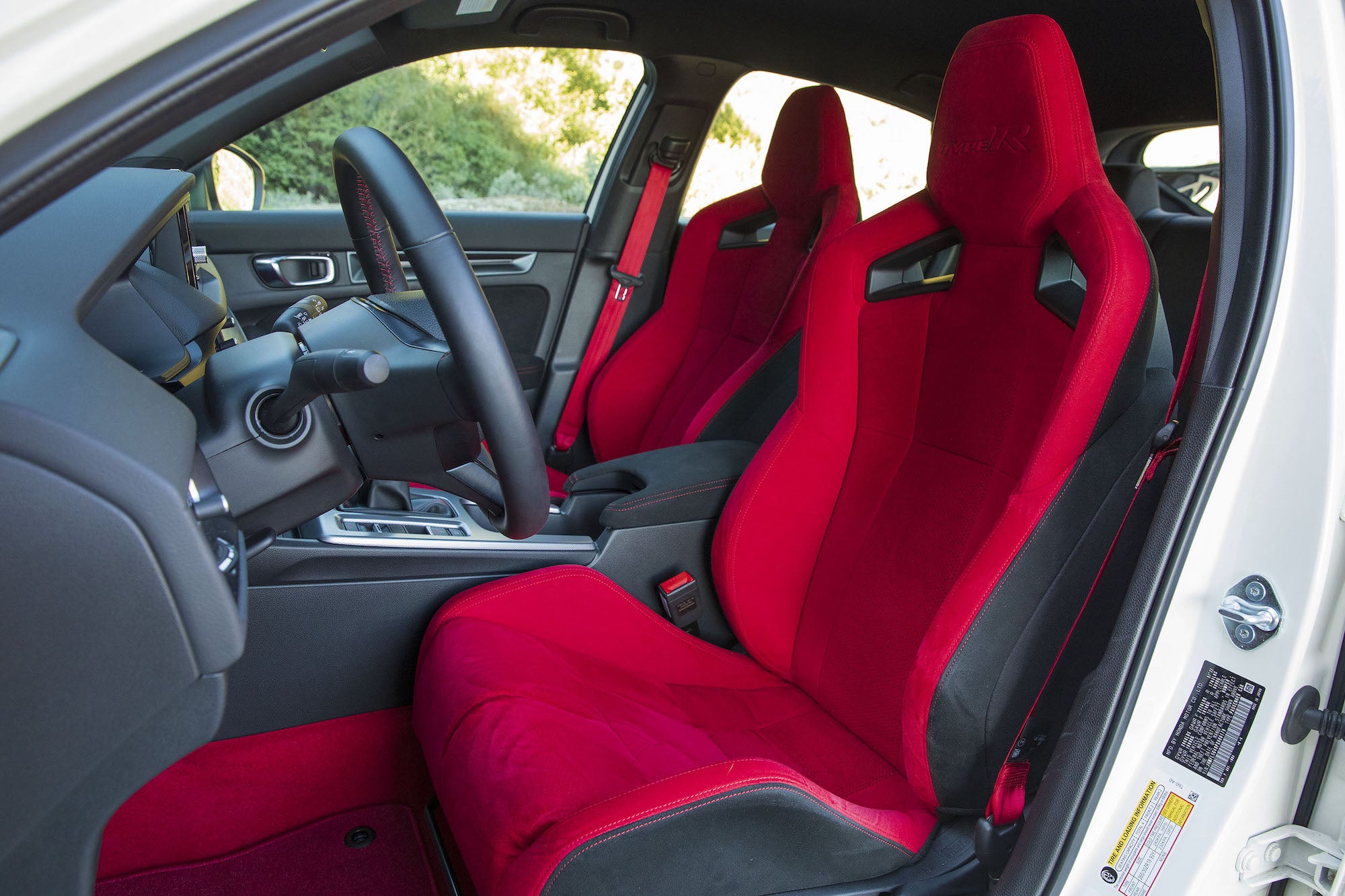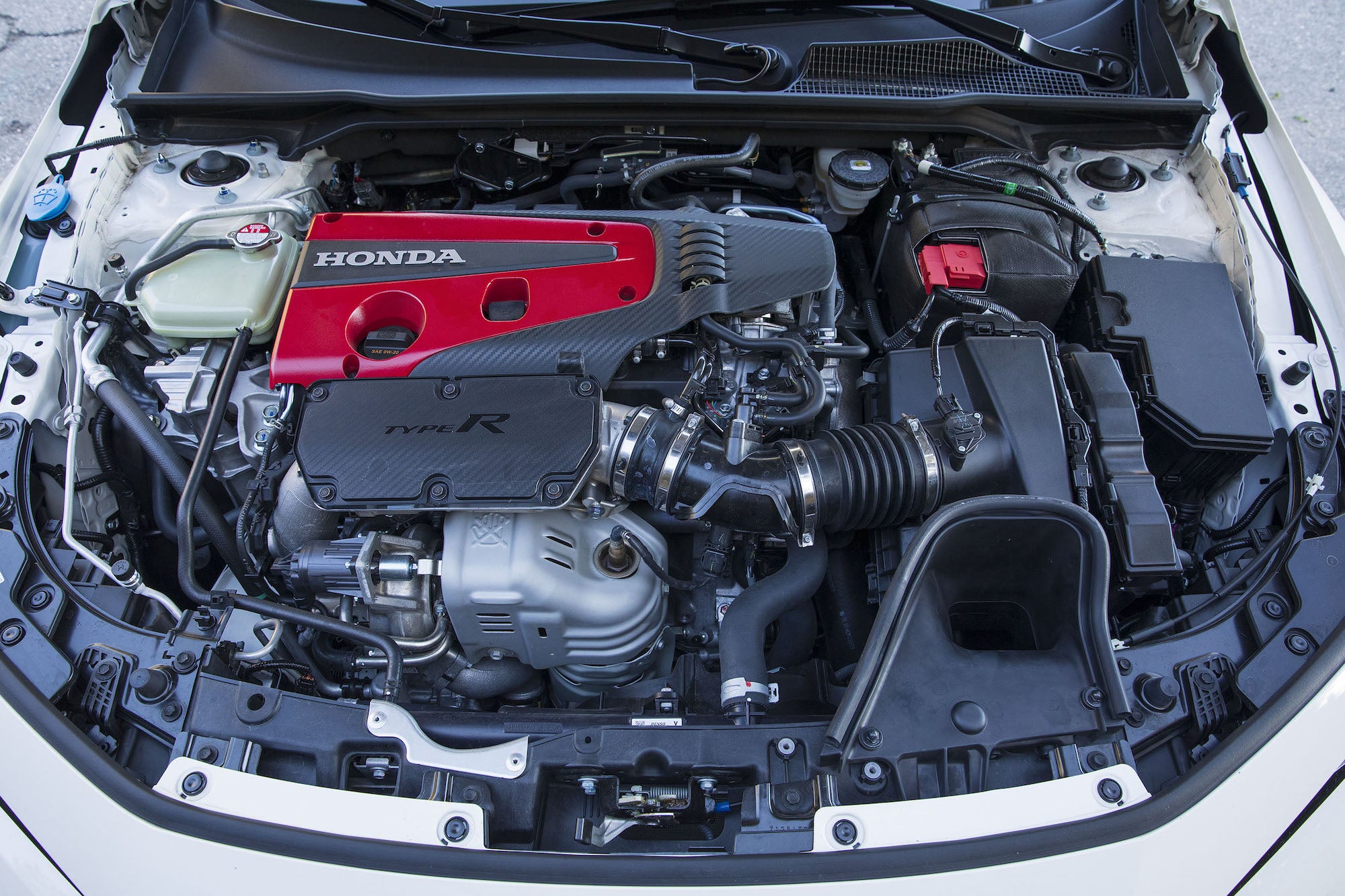
It might not be the first name that springs to mind when it comes to high-performance automobiles, but Honda has a deep-rooted history in motorsport as both a competitor and a supplier in racing series such as Formula One.
But for regular folks, its high-performance production car efforts have been less visible, particularly in the United States, and that’s due in part to the automaker’s habit of attaching the Acura nameplate to performance vehicles like the NSX and Integra for this market.
The disconnect is also bolstered by the fact that while the Civic Type R has been a well-known commodity in Europe for more than two decades, the model didn’t make its debut stateside until 2017. For the uninitiated, the Type R is no run-of-the-mill Civic. Tuned for the track, it boasts the power and poise to take on sports cars costing multitudes more, yet it also manages to retain all of the inherently pragmatic elements of a five-door hatchback. Don’t believe us? Just ask the current F1 champ.
When it did finally land on our shores in 2017, the Type R was introduced in one fully-loaded specification for just under $35,000 and quickly earned accolades for the masterful blend of engaging performance and everyday practicality that Honda had achieved. But its exterior design—a wild mixture of scoops, vents, wings, and curves—was not as warmly embraced, and that largely relegated the Civic Type R to the performance diehards who were willing to tolerate its polarizing aesthetic. Now underpinned by the eleventh-generation Civic architecture, the Type R has returned with a host of technological and performance upgrades, along with a more mature aesthetic that emphasizes function over form.
Refining the formula
Considering the near-universal praise for the Type R’s driving manners, Honda probably could have slapped new bodywork on it and called it a day. Instead, the automaker chose to scrutinize the car from stem to stern in order to find aspects to refine and improve. The 2023 model is lower, longer, and broader than its predecessor, boasting a front “track” (the distance between opposing wheels on the same axle) that’s an inch wider, while the rear track grows by three-quarters of an inch. Those changes necessitated the development of unique flared fenders in order to accommodate the additional girth.
In fact, every body panel forward of the A-pillar is unique to the Type R. While this bespoke sheet metal provides a more aggressive and purposeful look, it’s also designed to enhance airflow for more efficient engine and brake system cooling. Like its predecessor, the new Civic Type R also features a large, functional rear wing that improves high speed stability, but this time around it’s a more visually understated piece that yields better rear visibility. Combined with the aerodynamic elements integrated into the front bumper, underbody, side skirts, and rear diffuser, Honda says that the new car delivers more downforce with less drag and achieves the strongest aero balance of any Type R model ever developed.
Under the hood is an updated version of the 2.0-liter turbocharged inline four-cylinder engine from the previous Type R. Although it’s not particularly exotic (a nearly identical power plant can be found in the engine bay of a 2022 Honda Accord 2.0T), tweaks to the turbocharger design bump the engine’s peak output to 315 horsepower and 310 pound-feet of torque, making this the most powerful Civic Type R ever produced as well as the most powerful Honda vehicle ever sold in the United States. The reworked engine scores a more robust cooling system with a bigger radiator and a larger diameter fan, and it breathes through a new active exhaust system for a livelier soundtrack.
Power is sent to the front wheels exclusively through a six-speed manual transmission that can automatically match the engine’s RPM when downshifting for smoother transitions. The gearbox is matched up with a lightweight flywheel to deliver urgent throttle response as well as a new shifter for shorter, more satisfying throws.
As with its predecessor, a mechanical limited-slip differential is standard equipment in the Type R, as are upgraded brakes with four piston Brembo calipers and 13.8-inch rotors up front. The suspension, meanwhile, is noticeably firmer than a standard Civic in order to provide responsive handling and stability during performance driving maneuvers, but its three-mode adaptive dampers allow the system’s stiffness to range from relatively soft to track-ready. Michelin Pilot Sport 4S summer tires are also part of the deal, but if you want even more grip, the track-oriented Michelin Pilot Sport Cup 2 is available as a dealer-installed option as well.

The interior is still decked out in the Type R’s signature red-and-black motif, but the approach follows the exterior’s newfound sense of aesthetic restraint. New sport seats up front offer more substantial shoulder and thigh bolstering to keep occupants firmly planted when the going gets sporty, but changes to the internal structure are also on hand to enhance body support for better everyday comfort.
A new 9-inch infotainment display with a Bose audio system is also part of the package. Along with sharper graphics, improved input response, and wireless Apple CarPlay and Android Auto functionality, the new system offers enhanced real-time telemetry and other performance data through Honda’s LogR software. A Type R-exclusive digital gauge cluster is also on board and offers unique layouts for the Comfort, Sport, and +R driving modes in order to put information that’s relevant to the driving situation front-and-center.
A dedicated switch on the center console lets you quickly change between those drive modes, while a press of the +R button will immediately set all of the vehicle’s adjustable attributes to their most aggressive settings. The new Type R now includes an Individual drive mode as well, which allows you to create a customized preset rather than being saddled with the default programming of the Comfort, Sport, and +R modes. Want +R throttle response with Comfort’s suspension firmness? You got it.
Even at a notably more grown-up MSRP of just under $45,000—like the outgoing car, the new Type R is only available in one fully-loaded specification—the Civic Type R is an admirably comprehensive performance package. But what makes it special is how effectively all works together.

Behind the wheel
In recent weeks we’ve put the new Civic Type R through its paces on-track at Sonoma Raceway and carved corners throughout Napa Valley as well as the Angeles National Forest. We’ve also just used the Type R like a normal, everyday runabout in LA, and the number of cars we’ve tested that can handle all three scenarios as well as this car does could probably be counted on one hand.
While they lack heating and ventilation features, and also require a bit of extra effort to get into and out of versus its garden-variety counterparts, the sport seats in the new Type R are some of the best we’ve ever sat in. The shoulder and thigh bolsters are aggressive enough to keep the driver and front passenger firmly planted during performance driving maneuvers, yet these chairs also manage to be comfortable enough for extended stints on the road, and finding an agreeable driving position requires minimal fuss despite the relatively limited amount of adjustability available. It’s an impressive feat of design, and it sets the tone for the rest of the driving experience.
Honda has a well-earned reputation for developing some of the best manual gearbox setups in the industry, and the Civic Type R doesn’t disappoint on this front either. The automaker’s meticulous focus on driver engagement translates to a clutch pedal with just the right amount of resistance to feel substantial, but not taxing, and it’s paired with a shifter that offers satisfying, tactile precision.
Despite all of the performance-focused engineering found throughout the Type R, what’s immediately impressive is how easy it is to live with on a day-to-day basis. It is, after all, a Civic hatchback, and that means room for five adults and a substantial 24.5 cubic-feet of cargo capacity with the rear seats upright.
Hard plastics here and there remind us of the base Civic’s $25,000 starting price, but the cabin is generally a pleasant place to spend some time. Both the infotainment system and digital gauge cluster feature sharp, bold graphics that are thoughtfully laid out and easy to read at a glance, and the row of F1-style shift lights that are positioned just above the latter—which come to life as the engine approaches its 7000 RPM redline—are a cool, functional touch. Thankfully, and unlike a number of other automakers in recent years, Honda has also chosen not to abandon physical knobs and buttons in favor of capacitive controls, which often prove to be frustratingly difficult to use on the go.
While the Type R is happy to operate under the radar with a subdued exhaust note, a compliant ride, and relaxed driving manners not unlike a garden-variety Civic in Comfort mode, switching over to Sport or +R mode reveals its true nature. Its 315hp might not seem like much in a world where 800 horsepower factory-produced muscle cars exist, but in a car that weighs several hundred pounds less than a Porsche 911 Carrera, it’s more than enough grunt to keep things interesting both out on the street and when hunting down apexes on a road course.
Automakers typically shy away from producing powerful front-wheel drive cars due in part to torque steer, a situation where the tires are pulled off-center—or simply away from the intended path—during hard acceleration. Over the years, engineers across the industry have attempted to correct this issue while retaining a conventional strut front suspension design with limited success, so Honda decided to develop a unique dual axis strut suspension for the Type R in order to properly address the problem.
By adding a damper fork to the suspension design, Honda separated the steering knuckle from the damper, allowing the components to move separately from one another. The design also improves the suspension’s ability to vary camber, which lets more of the tires’ contact patch stay connected to the road during high-speed cornering, and it benefits the suspension’s caster angle as well. You can dive into the details of how it works here, but the big takeaway is that the dual axis design not only reduces torque steer to the point of being virtually non-existent, it also yields one of the most responsive and communicative high-performance steering systems on the market today—front wheel-drive or otherwise.
Combined with the gutsy turbocharged engine, satisfying gearbox, and ample stopping power from those big Brembo brakes, this is an immensely entertaining machine when hustled, yet it remains civil enough to be used every day, rain or shine. Although its matured look has brought an elevated cost of entry along with it, the new Civic Type R is one of the most well-balanced performance cars on sale today at any price, and the value of that is hard to overstate.
The post We drove the most powerful Honda in the US: A Civic appeared first on Popular Science.
Articles may contain affiliate links which enable us to share in the revenue of any purchases made.
from Popular Science https://ift.tt/c3Su6pz




0 Comments